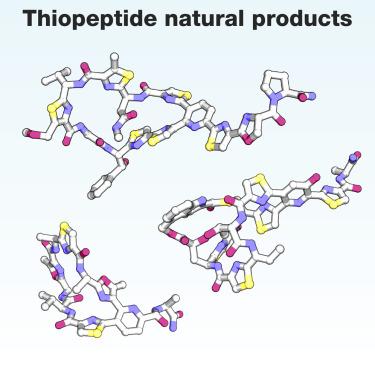Cell Chemical Biology ( IF 6.6 ) Pub Date : 2020-07-21 , DOI: 10.1016/j.chembiol.2020.07.003 Alexander A Vinogradov 1 , Hiroaki Suga 1

|
Thiopeptides (also known as thiazolyl peptides) are structurally complex natural products with rich biological activities. Known for over 70 years for potent killing of Gram-positive bacteria, thiopeptides are experiencing a resurgence of interest in the last decade, primarily brought about by the genomic revolution of the 21st century. Every area of thiopeptide research—from elucidating their biological function and biosynthesis to expanding their structural diversity through genome mining—has made great strides in recent years. These advances lay the foundation for and inspire novel strategies for thiopeptide engineering. Accordingly, a number of diverse approaches are being actively pursued in the hope of developing the next generation of natural-product-inspired therapeutics. Here, we review the contemporary understanding of thiopeptide biological activities, biosynthetic pathways, and approaches to structural and functional reprogramming, with a special focus on the latter.
中文翻译:

硫肽介绍:生物活性,生物合成和功能重编程策略。
硫肽(也称为噻唑基肽)是具有丰富生物活性的结构复杂的天然产物。硫肽因有效杀死革兰氏阳性细菌已有70多年的历史,在过去的十年中,人们对硫肽的兴趣重新兴起,这主要是由21世纪的基因组革命引起的。近年来,从阐明其生物学功能和生物合成到通过基因组挖掘扩大其结构多样性,硫肽研究的各个领域都取得了长足的进步。这些进展为硫肽工程化奠定了基础并激发了新的策略。因此,正在积极地寻求多种多样的方法,以期希望开发出下一代的天然产物启发疗法。这里,











































 京公网安备 11010802027423号
京公网安备 11010802027423号